Five months ago, I wrote a blogpost titled The Keys to Stronger Deadlifts. Since it was very well received, I decided to do the same type of article for the squat.
The most difficult position in the squat occurs right after the lifter comes “out of the hole”, at least in terms of joint torque magnitudes. This is especially true for raw squats, since squatting gear (briefs, squat suits, and knee wraps) provides enormous passive elastic assistance at the bottom of the lift. Still, positioning and explosiveness out of the bottom position in the squat play a large role in determining where the lifters’ sticking point will be. It is thought that ideal foot positioning and trunk angle in relation to the lifters’ specific body proportions play a large role in making a successful squat. But what exactly are the critical factors in elite level squats?
In this article, I have freeze-framed and snipped pictures of 41 of some of the strongest squatters in the world in the deepest positions during their squats. For comparative purposes, I made sure to include both geared and raw squatters. And though the list is predominately made up of powerlifters, I also made sure to incorporate a mixture of strongmen, Olympic weightlifters, and bodybuilders.
Please examine the following kinematic aspects of the squat in this article: squat depth, stance width, foot flare and pressure, shin angle relative to the floor, knee position in relation to the foot, torso angle, degree and location of spinal flexion, bar positioning on back, grip width, head-neck positioning, and direction of gaze.
Andrey Malanichev 1,058 lbs
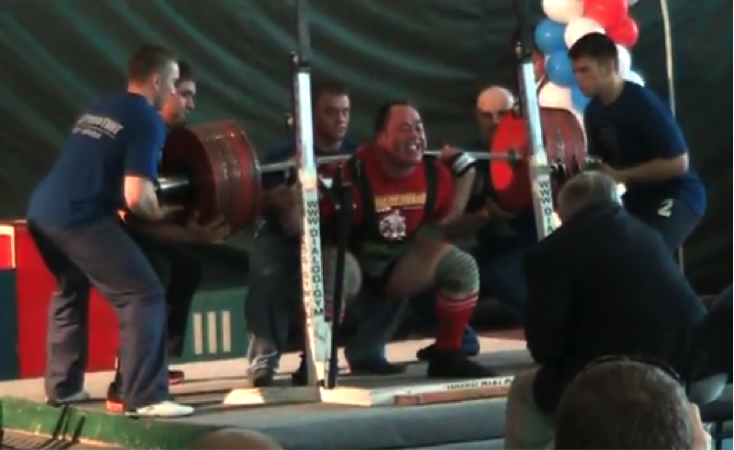
Andy Bolton 1,213 lbs

Ben Rice 650 lbs

Bill Kazmaier 849 lbs

Brandon Lilly 826.5 lbs

Brian Carroll 1185 lbs
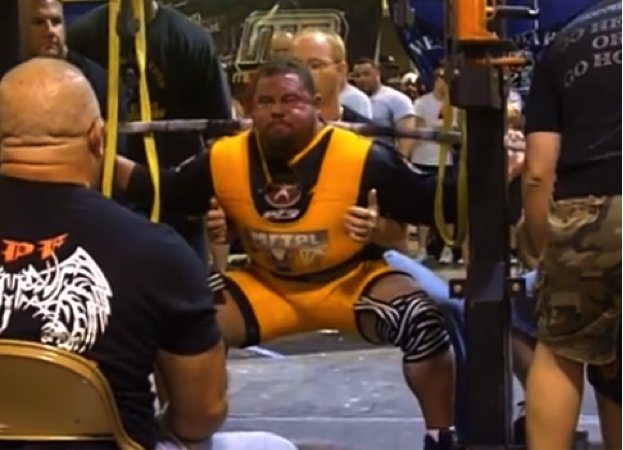
Chad Wesley Smith 905 lbs
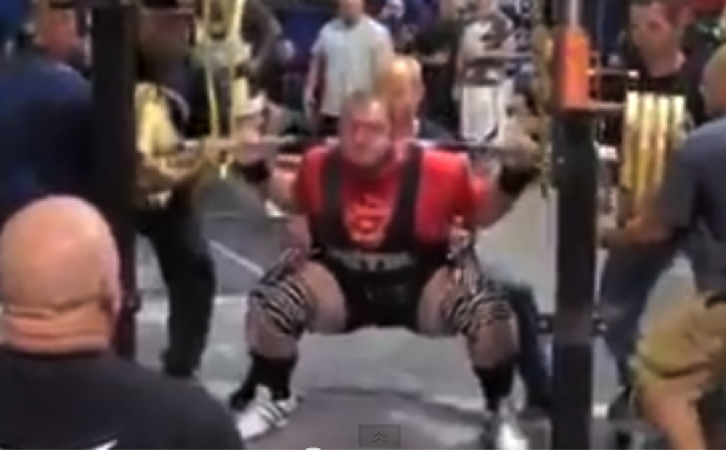
Dan Green 800 lbs

Dave Hoff 1,210 lbs

Dmitry Ivanov 1,017 lbs

Dmitry Klokov 542 lbs with 5 second pause
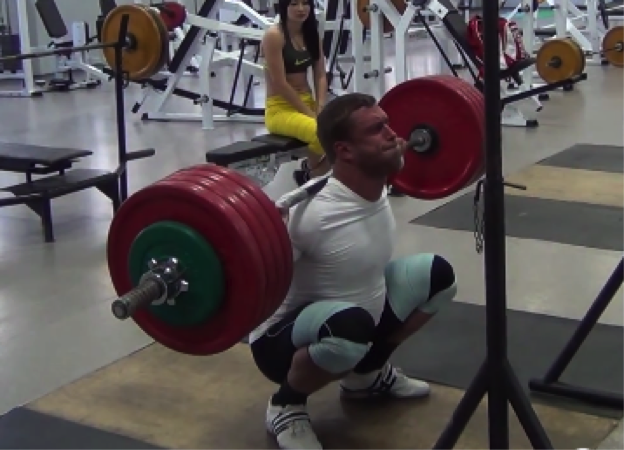
Donnie Thompson 1,265 lbs

Fred Hatfield 1,008 lbs

Jonas Rantanen 1,268 lbs

Idalberto Arranda 616 lbs

Jesse Norris 700 lbs

Laura Phelps 750 lbs
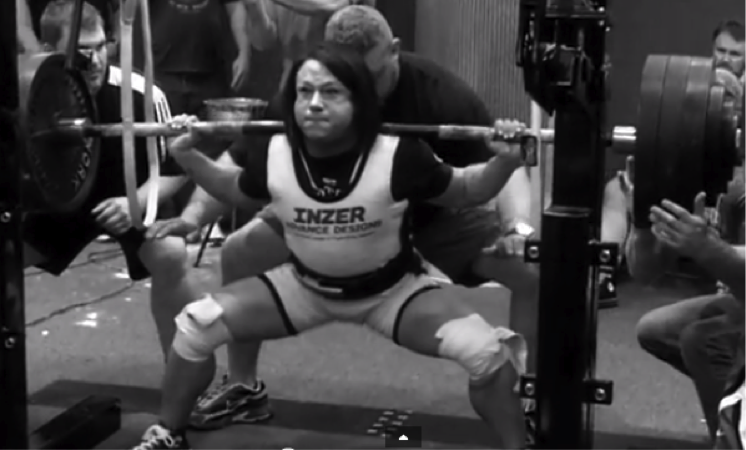
Layne Norton 615 lbs

Michael Tuchscherer 744 lbs

Mike Miller 1220 lbs

Mikhail Koklyaev 796 lbs

Pat Mendez 800 lbs

Pete Rubbish 661 lbs
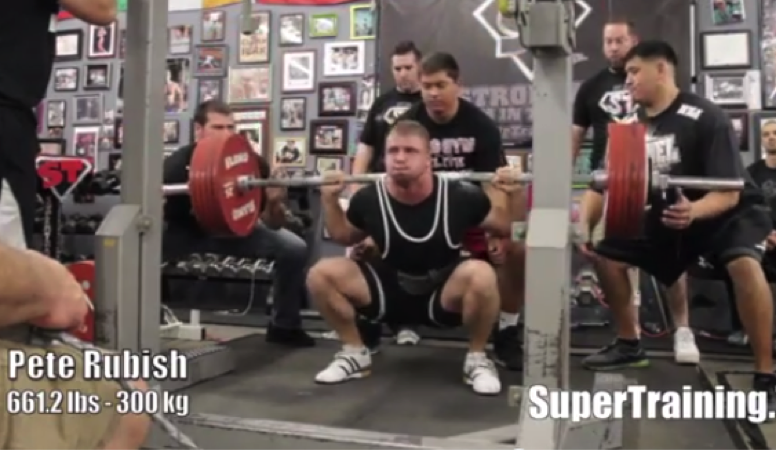
Ray Williams 883 lbs

Robert Wilkerson 1,000 lbs

Sam Byrd 1,050 lbs

Stan Efferding 905 lbs

Steve Goggins 975 lbs x 2 reps

Wade Hopper 815 lbs
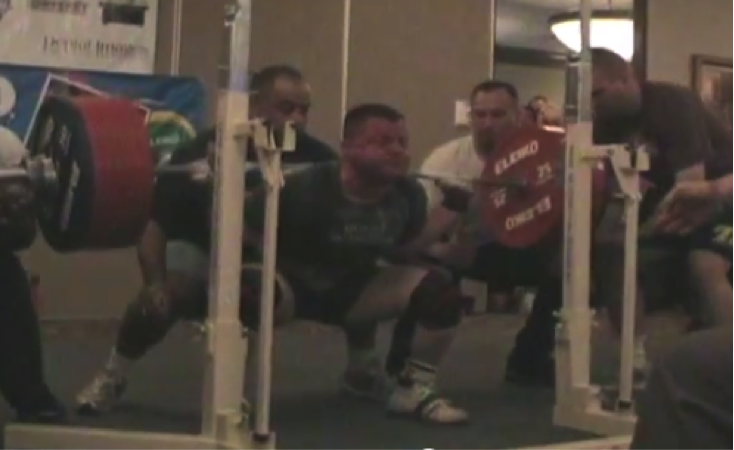
Eric Lilliebridge 926 lbs

Ed Coan 1,003 lbs

Chuck Vogelpohl 1,114 lbs

Brent Mikesell 1,137 lbs

Kirk Karwoski 968 lbs

Paul Childress 1,125 lbs

Hossein Rezazedeh 672 lbs x 2 reps

Anonymous Chinese Weightlifter 441 lbs x 13 reps

Jesse Marunde 407 lbs x 20 reps
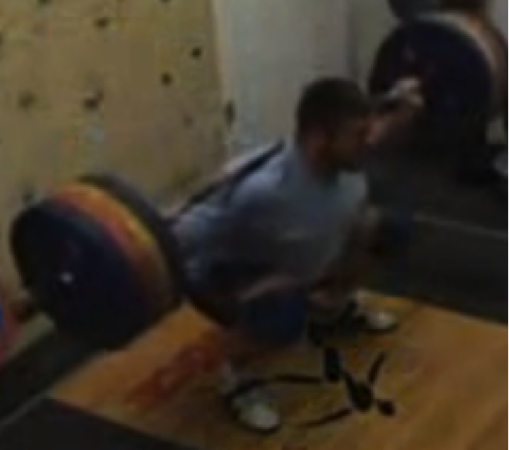
Ronnie Coleman 800 lbs

Tom Platz 525 lbs x 23 reps

Brandon Curry 495 lbs x 12 reps

What did you observe? Here is what I see:
Different styles (and depths) per group of athlete
Bodybuilders typically squat above parallel and keep their torsos very upright. Many don’t even lockout at the top. These are all strategies to increase tension and metabolic stress on the quadriceps.
Raw powerlifters typically squat deeper than geared powerlifters due to the gear. It’s actually quite hard for many geared powerlifters to reach depth – this is not a function of their hip mobility but rather a function of wearing support gear.
Olympic lifters squat rock bottom with very upright trunk positions to increase the transfer to their Olympic lifting pursuits.
Shin angle relative to the floor
Most of the lifters’ knees come out in front of their toes, with the exception of geared powerlifters. The raw powerlifters, bodybuilders, and Oly lifters have more forward knee migration, but the geared powerlifters sit back more in order to get more out of their supportive gear.
Stance width
Most of the lifters set their stance at shoulder width or slightly wider, with the exception of geared powerlifters, who tend to go wide (with some going ultra-wide).
Foot flare and pressure
All the lifters have some degree of foot flare. None of these lifters squat with their toes pointing straight ahead. As the stance widens, hip external rotation and foot flare tends to increase. All of the lifters keep their feet firmly planted onto the ground, with none of them rising up onto their toes or failing to maintain heel contact.
Knee position in relation to the foot
When looking at knee positioning relating to the big toe, the majority of lifters exhibit some degree of medial knee displacement (knee valgus). Most of the bodybuilders and Olympic weightlifters kept their knees out, making sure they tracked over their toes, and the powerlifters who set up with narrower stance widths tended to keep their knees out over the toes (those with wider stances exhibit more medial knee displacement). In addition, many of the lifters exhibited what I call a “valgus twitch” during the initial ascent of the concentric movement, meaning that their knees moved inward slightly and then back outward.
Torso angle
Most of the lifters have a somewhat upright torso. This isn’t always the case throughout the lift though. Some of these lifters allow their hips to shoot up when coming out of the bottom position of the squat, while others maintain this upright torso position throughout the lift. Moreover, a few of the lifters exhibit what some would say is excessive trunk inclination (greater than 45 degrees in angle), indicating that it’s quite possible to have world record squat strength with marked forward trunk lean.
Degree and location of spinal flexion
Nearly all of the lifters keep a fairly neutral spinal positioning throughout the squat. Even with different torso angles, the various lifters’ backs seem to stay in a pretty neutral position, with the chest up (thoracic extension) during the lift. Only one lifter (raw) tended to exhibit thoracic flexion, which occurred halfway up during the concentric phase.
Bar positioning on back
There seems to be no rhyme or reason when it comes to bar position. You see lifters using a high bar position with closer and wider stances, and you see lifters using a low bar position with closer and wider stances as well. The majority of geared powerlifters use a low bar position, but not all. Olympic lifters and bodybuilders tend to utilize the high bar position to better mimic their sport or increase stress on the quads. While the majority of raw powerlifters still utilize the low bar position, a greater percentage of them use the high bar position compared to geared powerlifters.
Grip width
Those lifters who compete in heavier weight classes seem to utilize wider grips while those who compete in lighter weight classes seem to use closer grips. This can be related to either shoulder mobility restrictions or comfort.
Head-neck positioning and direction of gaze
All lifters either display a neutral or extended head-neck positioning during their squat, with no lifter having a flexed neck posture. The lifters choose to look different places while squatting, with some looking down at the floor, some looking straight ahead, and some looking up.
Conclusion
So what are the keys to stronger squats?
- Push through the heels (don’t rise onto the toes)
- Keep the chest up (don’t allow the spine to flex)
- Flare the feet out slightly (don’t point them straight ahead)
- Keep the head/neck in neutral or extension (don’t flex the neck or point the head downward)
That’s it! Stance width varies, bar position varies, trunk position varies, shin angle varies, knee position varies, and grip width varies considerably from one lifter to the next. This indicates that lifters should experiment to find which squat style and form works best for them, rather than trying to mold their form to mimic a preconceived style.
Take some pictures of your heavy squat form and compare it to the pictures in this article. If something is off, then you might be leaving some room on the table for increased strength. Remember, it’s highly unusual to learn a new technique and immediately set a PR in the gym. If your form isn’t up to snuff, start working with your technique, and remember to gradually increase the loading. However tempting it may be, be patient and let form improvements “cement” so you don’t end up reverting to old habits. Hopefully I’ve helped arouse excitement for your next squat session. Train hard and train smart.






Awesome job analyzing all those different squats! Due to the degree of variability in grip width, it’s certainly difficult to make a recommendation for what produces the strongest squat. However, if it’s mobility *restrictions* that lead to wider grips, do you think it’s wise to work on mobility and aim for a narrower grip? Does a narrower grip confer any benefit?
I personally find that having a narrower grip allows for more tightness in my squat, which increase my stability and ultimately weight. If I keep them narrow for too long I get too much valgus force in my elbow. Elbow pain.
As far as mobility work, it’s hard work, but I’ve been incorporating light power stnacthes as a way to train for better shoilder mobility.
Great info as always BC!
Hey bret I was curious about elbow positioning. On both a high and low bar do you think it would be good to cue someone to keep there elbows underneath the bar(meaning pushing them forward) at all times to keep the chest out and not hunched over? I saw that Tony Gentilcore likes to give the analogy of squeezing oranges between your arm pits to stay tight and tall with the chest. What are your thoughts?
Semi-related, here’s an interesting discussion on squatting biomechanics
http://www.youtube.com/watch?v=qHTZuQHYgAQ
Chris, I’m only part of the way through the video, but the model seems a little simplistic… Do they mention the glutes?
Bret, great content as usual. If you have time, can you briefly discuss footwear (i.e., heel lift vs no heel lift; olympic shoes vs minimus/Chuck Taylors)? I feel this topic is relevant to the discussion, and I would love to hear your opinion. Thanks!
Awesome! Thank you for writing this and clarifying things. I feel better that squatting styles are different for everyone as long as basic rules (like you mentioned) are followed.
Now, if only I can somehow loosen up my thoracic spine…all will be good :). I have a tight TS and I am not sure if it is even possible to get better mobility in your thoracic spine. Are there ways to strengthen and/or increase mobility for the “shelf” for the bar?
Question…..is the “valgus twitch” the body’s attempt; i.e., an unconscious action, to find a stronger, more powerful position at that point of the lift? The position of the legs at that point closely resembles, if only for a brief instant, the starting/power position at the start of a lift.
One would think that’s it’s not something lifters do on purpose
The final list of findings seemed a bit less surprising for squats than your deadlift article. What, if anything, surprised you the most after analyzing all these squats?
I think that the focus on the hole of the squat,.. meaning going low is not important for recreative gymrats as for all of you that are in competition are forced to go deep.. The picture’s seem to force us in the hole.. But okay there is always, .. the hole. Reacreative gymrats don’t need to force themselves. Going a little at under parrallel is enough. In the “deep” hole everything is against you.. Your muscles are stretched, so at the weakest point and then you also have to break the movement keep it and then turn it up… there. For training your legs it’s good enough to stop before that in your stronger part of the movement and go for more reps to force for strangthgains.
Stronger squats Title of this post) can also mean.. being stronger in 5 rep squats in the better controleable ranges without being surrounded by other people.. I write this because I never practice max-squats while that is not the goal of my squatting. Most people don’t train for 1-max-competition. And I missed that in this post. But I can be wrong.
Another useless article, Bret.
Lifters shouldn’t simply ‘experiment’, what utterly shitty advice. Especially given your title since nowhere did you give even a single KEY to a strong squat. You did a lot of SEO for the word squat which, as we both know, was your goal. Though you missed a trick with your shitty alt tags.
In any case, rather than ‘experimenting’, lifters should determine what squat is best for their goals. Hypertrophy? PL’ing competition? Basic strength? Sports performance? To support OL’ing? That predominantly determines the choice of optimal type of squat.
Lifters can adjust from there based on things like bodytype, mechanics, strengtch, equipment, etc.
Lyle
Shots Fired…
Lyle, useless? You can’t learn anything from all the screenshots and make some generalizations? Lifters shouldn’t experiment? WTF?
This is the second time you’ve accused me of SEO stuff – I corrected you the first time. I don’t have the slightest clue about SEO. I’ve never read a book about marketing or anything. If I was trying to figure out a title that people would search for, it wouldn’t be the title I came up with. In other words, I don’t think some powerlifter is out there looking for help with his squat and is going to type onto the internet, “the keys to stronger squats.” I didn’t tag the article either. On another note, I don’t comment on any of your articles. Since you comment on mine, should I accuse you of trying to gather attention from my blog?
Anyway, I completely agree with your last several sentences. Lifters should indeed determine what squat is best for their goals, adjust from there based on things like bodytype, mechanics, equipment, etc., and also experiment to see if other types of squats help build their preferred squat (example, front squats).
Silly boys getting into a pissing match. Way to keep it classy….
Hi Bret.
I’va got non-functional glutes and a bunch of problems, which is why I am reading.. you see, I wonder how the hell did I manage a 100kg squat without even using my butt 😀
Anyhow, the point here is this:
Am I correct in understanding, though, that the knees should not go over the toes untill the last moments of the lift (e.g. last third before hitting bottom) and that the lift should be initiated with the bottocks? My understanding is that the shin should be nearly 90 degrees to the ground for quite a long way into the squat, untill hip movement is mostly used up, therefore firing the glutes quite effectively? (Btw. this is NOT how I used to squat)
Thanks so much, Bret.